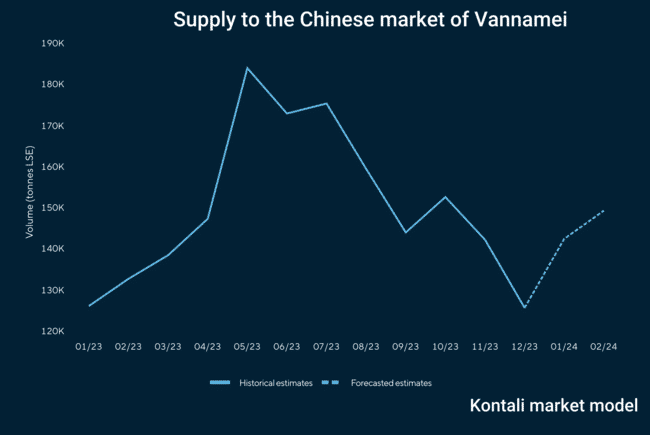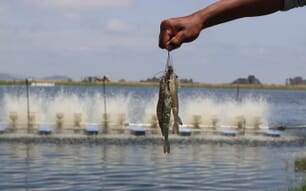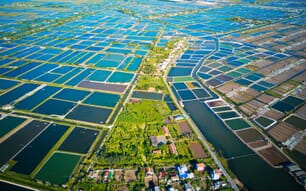
© Pierre Banoori Photography
However, despite the challenge, there is now a sufficient level of reliable data available to help shrimp traders, feed providers and investors make informed decisions that can improve their operations, according to Sander Visch, lead shrimp analyst at Kontali.
“We can provide much deeper insights into the industry, with models that help us to predict what’s happening in the production level, the market level and the species level,” Visch explains.
While Kontali’s analytical powers are well established in salmon, the Norwegian-headquartered firm only diversified into shrimp in 2020, with the acquisition of Seafod-Tip, the company behind Shrimp Tails – a magazine co-founded by Visch. A self-confessed aquaculture nerd, he has been in the sector for close to two decades: following a masters in aquaculture at Wageningen he went on to run Seafarm – one of Europe’s pioneering RAS flatfish producers – for seven years, before branching into sectoral analysis.
“I’ve gone from the production side, when my focus was on fish growth and water quality issues, to now having a much broader overview of the market and the trade and the supply chains. Our aim is to now bring up our shrimp intelligence up to the level we have in salmon,” he reflects.
In order to do so, Kontali engaged a team of analysts, data scientists and developers to produce a shrimp-facing version of Edge – which was launched in September (a year after the salmon version of the platform) and offers subscribers an opportunity to analyse, and creates models from, a wide range of data relating to the sector.
However, Visch is well aware of the size of the task in hand.
“Shrimp is a very different sector from salmon. The production cycle in salmon is 25-30 months, so if the fish are stocked we know when they will be coming to market, but for shrimp the cycle is 2-3 months, so it’s much harder to get a short term idea of what’s happening. That’s one of the things that we’re working on,” he reflects.
“But there are similarities in a lot of the drivers – supply, demand, pricing, perhaps even the trades are similar. Especially when you look at forecasting, there’s lots for the shrimp world to learn from the salmon world and we’re working on those models,” he adds.

The company expects to see demand in China rise in the first half of 2024 © Kontali
Visch expects that Edge will initially appeal mainly to investors, exporters, producers and feed providers, by offering useful insights at a time when margins are tighter than they have ever been.
“Prices might be down for the foreseeable future. Even though inflation is normalising, consumption demand has not yet increased. So there’s a lot of insecurity in the sector about what’s going to happen in the next 3-6 months, about what the markets will do. And this relates to investments and whether farmers should start stocking their ponds – that is something that we’re looking to address by building models, to make better predictions and take away market uncertainties,” he explains.
How can analysis help?
“We don’t claim the models will tell you precisely what you should do or what’s going to happen, but they help people to make better decisions, based more on data and less on sentiment – in shrimp too many decisions are still based on gut feelings, while there’s a huge pile of data that’s not yet been looked at, especially by the smaller companies and we can support their decision making in their day-to-day operations,” Visch argues.
According to Visch, Kontali’s work in the salmon sector helps to illustrate what can be achieved, helping operators to understand the impacts of factors like stocking levels, feed sales, and productivity estimates.
“In the shrimp industry no one is collecting or analysing these kinds of data on a global scale. It’s about changing the mindset of the shrimp industry, making it more like salmon, which is data-driven and professional and has shown how much there is to gain from using data,” Visch explains.
“We’d like to reach a more predictable market and supply – so that farmers can make investments, feed companies can make investments, and the sector is also able to attract [external] investors in the production level. It’s where investors are a bit wary, because they don’t have the data and don’t know what’s going to happen in the next years,” he adds.
In terms of the range of the models being developed, Visch notes that – given shrimp’s short production cycle – it’s more important to understand fairly short-term trends, than longer-term ones.
“We have models up to 2030 for production and markets, but we’re mainly trying to focus on 3-6 months ahead, as that’s the period where the decision making process is most important, whether you’re a farmer or an exporter,” he says.
Looking ahead
Now that Kontali has models established for vannamei, Visch says they are looking to build similar ones for other species, including monodon and wild-caught Argentine red shrimp, due to the degree of competition between the various shrimp sectors.
They are also looking more closely at the markets in specific countries, rather than whole regions, as well as feed price indexes and forecasts.
Given the nature of the shrimp sector, Visch knows that he’s facing a challenging task, but even incremental gains will be welcomed by an industry that needs all the help it can get.








